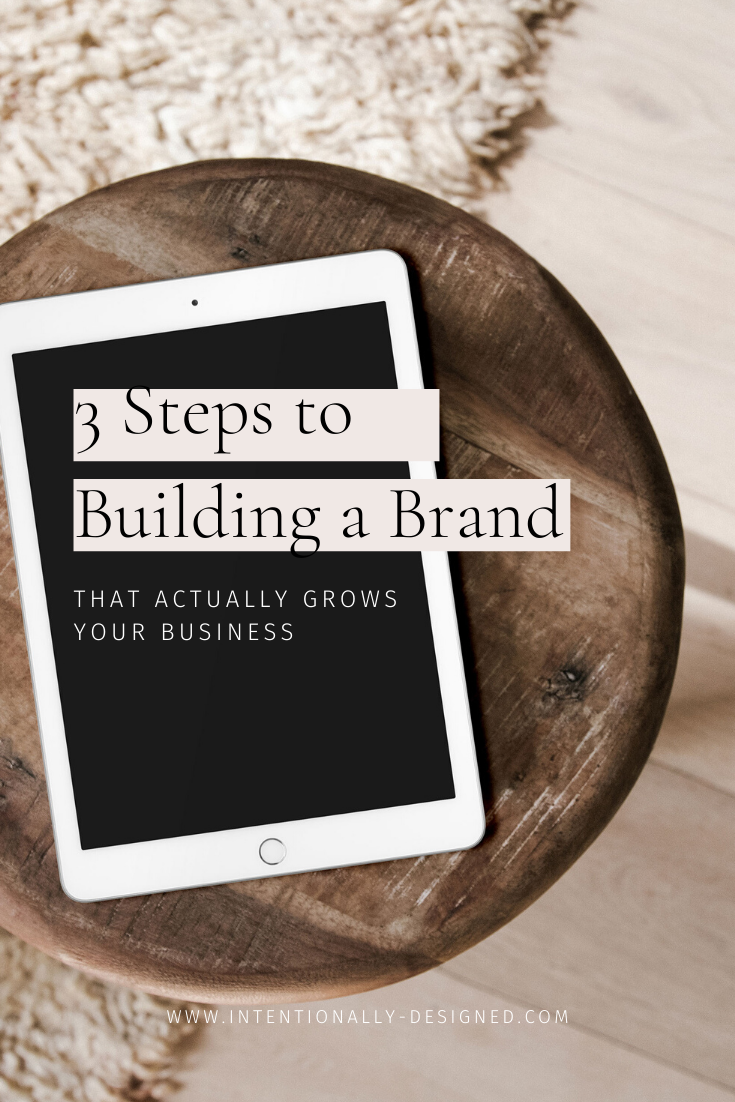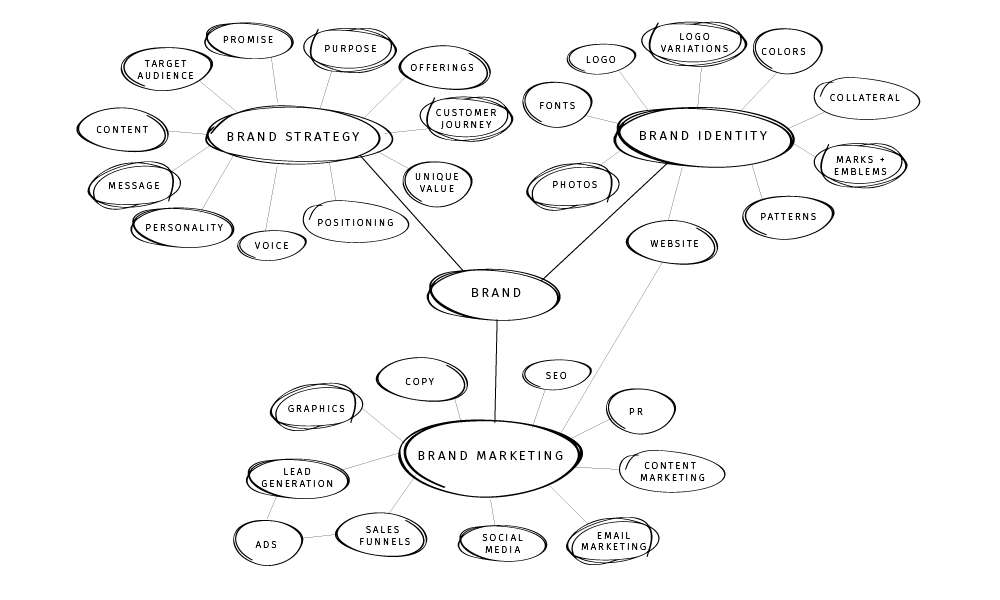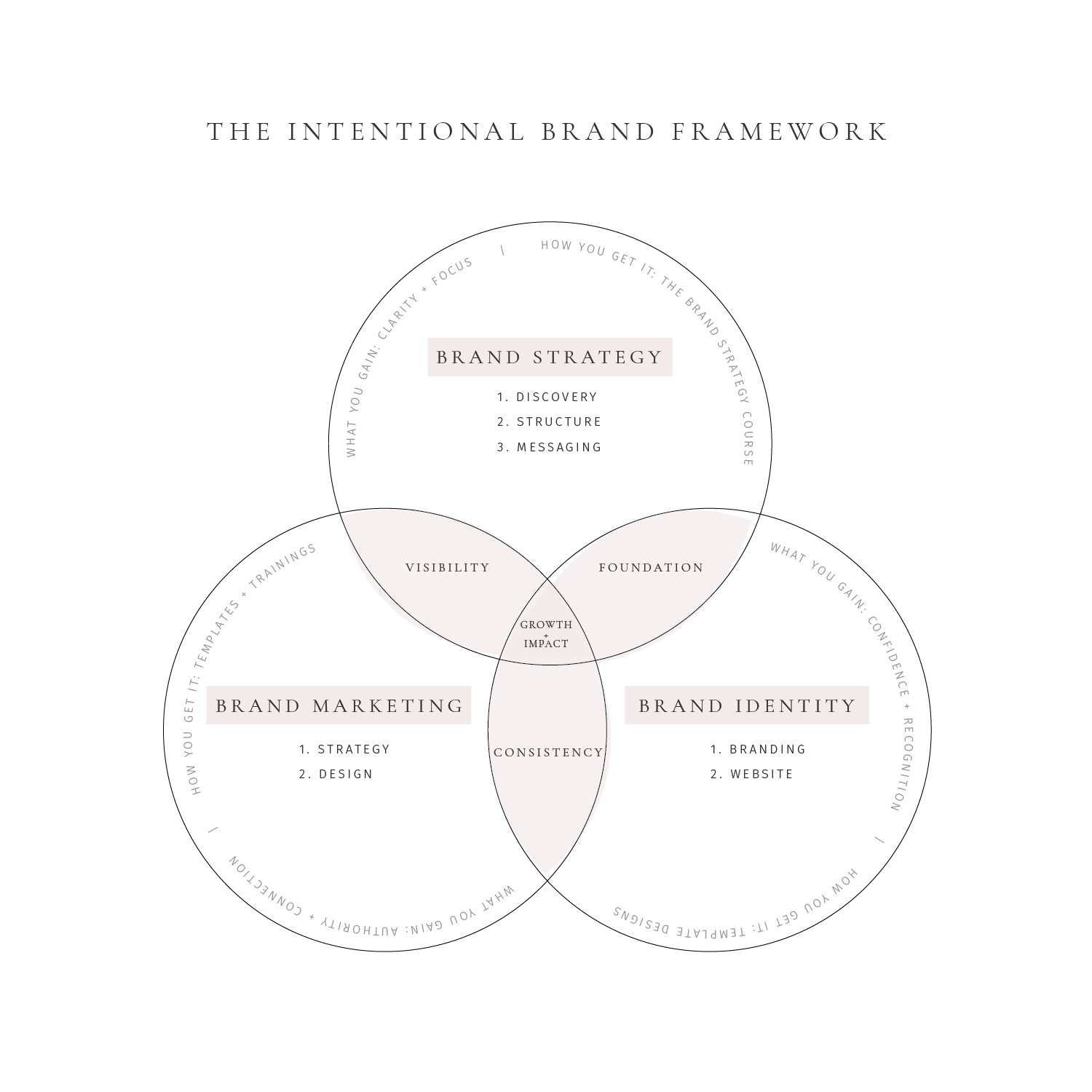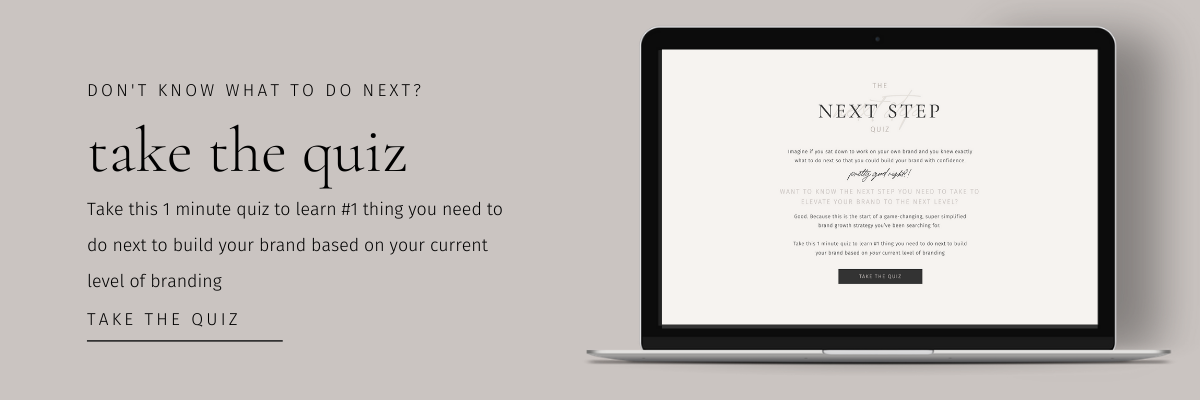Sometimes branding can feel overwhelming. It can feel like a daunting task to build a brand for your business. Most business owners know that branding is important, but they usually put it on the back burner to all other business-building activities, which could end up costing you time and money in the long run.
You can piece together your brand over time, but it will likely end up inconsistent and confusing and won’t help in growing your business. On top of that, you will end up spending more time and money trying to refine and recreate things so that they work better for your business.
Before you try to gain momentum with your marketing efforts, you need to build the foundation of your business first with your brand. If you build your brand the right way it can serve as the groundwork for massive growth in your business. But when building a brand feels so overwhelming, where do you start? Let’s break it down →

Here’s what you’ll learn
- A clear definition of a brand and an online personal brand
- What exactly a brand encompasses
- The 3 phases of building a successful brand
- Why you’ll go through this process again and again at each level of your brand
What is a brand?
Most people are guilty of assuming that your brand is the visuals that are associated with your brand, but that’s just the surface level element of something much deeper. Your brand is who you are and what your business stands for. Your brand is your logo, website, and marketing, but it is also your purpose, promise, ideal client, message, personality, and much more.
The surface level of your brand is the things that you see first like your logo and website which are better referred to as your branding, but your brand as a whole encompassed much more. Your brand is your entire identity as a business.
A brand isn’t just made up of visual elements and pretty things. Your brand is every piece that represents your business from your ideal client and message to your logo and website. Your brand represents your identity in your market – who you are, what you do, how you are perceived. In order to create a cohesive and intentional brand, you have to bring it all together. Each detail tells a part of your story. Each part communicates something to your audience.
What is an online personal brand?
Because I typically serve online personal brands, I wanted to take it a step further and give you a better definition of this along with defining your brand as a whole. A personal brand is connected to an individual. It’s when you can clearly put a face to a business and you build a connection with the person behind the business. In comparison, a business brand tends to be focused on the business as a whole. It’s less personal as you don’t tend to see the face behind the brand.
A personal brand is what you typically see in the online creative world today. Most people have built their own small businesses and are the face of their brand. Whether they are running it by themselves or have a small team of employees, what constitutes a personal brand is the fact that they are front and center of the brand, making personal connections with their audience, and typically the one creating and distributing their offering.
Now what about the online part? If your brand is mostly based online, then you have an online brand. Even if you do events in person, or possibly have a brick and mortar store, you could still have an online brand if you mostly run your business online.
Typical online personal brands that you see are photographers, authors, speakers, influencers, designers, educators, and bloggers.
What’s in a brand?
Now that you know what a brand actually is, and how to define and online personal brand, let’s dive into what exactly is encompassed in a brand. A strong and intentional brand is made up of several elements. It typically includes your brand strategy, your brand identity, and your brand marketing – which are then broken down into their own set of elements too.

Below is a checklist for the essential elements of a strong brand. Do an evaluation of your current brand. Do you have all of these elements in place?
- Brand Strategy
- Target audience
- Purpose
- Promise
- Offerings
- Customer Journey
- Differentiation
- Positioning
- Voice
- Personality
- Message
- Content
- Brand Identity
- Logo
- Logo variations
- Color palette
- Font palette
- Brand marks and emblems
- Brand patterns
- Brand photography
- Collateral
- Website
- Copy
- Photos
- Style
- Layout
- Brand Marketing
- Copy
- Graphics
- Lead generation
- Sales funnels
- Social media
- Email marketing
- Content marketing
- PR
The 3 steps of building a brand
Your brand is the foundation for everything in your business. With a solid foundation in place, your business is prepped for unstoppable growth. Having a clearly-defined, well-thought brand can make such a big difference when trying to market and grow your business.
But if you don’t do it the right way, it might not be as effective. If your brand is pieced together over time in a random and inconsistent way, it will come across that way to your audience and potential clients.
Instead of jotting down some notes and throwing together a pretty design, let’s think about it a different way.
My signature 3 step brand building process breaks this down differently so that you can intentionally develop each stage of your brand in the right order so they build upon the next and result in more effectiveness.
By following these 3 steps to build your brand, you are more likely to end up with a strong foundation that will act as the groundwork for incredible growth in your business.

Step 1: Get clear on the foundation of your brand
Brand strategy is the first part of my process because everything else will stem from this. This is the foundation of your business and defines things like your target audience, positioning, and messaging. You might already have a business strategy and probably have a marketing strategy, but what connects those is a brand strategy.
Skipping ahead to marketing before defining your brand is the most common mistake I see entrepreneurs make. Now I’m not talking about the logo and graphics that go along with your brand here. I am strictly talking about the foundational strategy of your brand. Design plays a pivotal role in the growth and success of any business. But it’s about more than just the design, it’s about the strategy behind that design and how you visually communicate that with your audience. Without the strategy, your brand and website won’t do any good, no matter how beautiful they are.
Before you try to put all your time and effort into designing your brand and marketing your business, you need to start here so that the designs you create and the marketing you do will make more sense and be more effective.
Step 2: Create an elevated online presence
Only after you have fully developed your brand strategy can you create the next part of your brand – your brand identity. A brand identity is made up of two main components: the visual part like your logo, color palette, typography style, and photography style, and the voice part like your tone, manner, voice, and communication style.
Most business owners skip straight to this part because it feels easier than tackling the strategy. It’s more fun to pick out your colors and fonts so naturally, you would want to do the fun part first. But in reality, you could spend a lot of time and money developing a pretty brand that might not communicate the right message to the right person.
Without a solid brand strategy in place, there is nothing to guide the design process. Your brand strategy helps in creating your brand identity because it gives you something to start with. Instead of picking fonts, colors, and style based on current trends or your personal favs, you are making those decisions based on who you are trying to reach, what you are trying to say, and how you want to build your brand. The strategy establishes the direction and goals of your brand and your identity is how you begin to execute it.
With a strategy based brand design, you can be more confident that the design will effectively communicate the right message and look good at the same time.
Step 3: Develop a clear marketing strategy that generates visibility
The last step in building your brand is to execute your brand through marketing to influence the right people, generate more leads, monetize your services and products, and position your brand the right way.
So now that you have your brand strategy defined, and your brand identity designed, you can take all those pieces and put them together in your marketing. This is when you’ll create your website, email marketing, collateral, etc that clearly represents and communicates your brand strategy using the brand visuals and bringing it full circle.
Sometimes people will jump straight into a website because they think they need an online presence to be successful. While it is true that having a website is important and essential for any online business, you can’t just throw it together and expect it to make millions either.
Your website is an extension of your brand identity and the main marketing piece that will layout your brand strategy clearly and concisely for your audience. In the beginning, you might have a simple website that gets your business out there and gives you a starting point, but this will only last so long. Eventually, you need to bring it all together and connect it with your brand strategy so that it actually makes sense and does what you need it to do to grow your business.
The same can be said for any marketing piece that you create for your business. When you create these pieces with the right strategy behind it, you get much better results.
Recap
The next time you think about your brand and are scared of what that entails, just remember that it is simpler than it seems. While creating an intentional brand takes a lot of time and thought and shouldn’t be thrown together, it doesn’t have to be overwhelming and daunting either.
When you build your brand in this order, you can more effectively create a brand that lasts and grows with your business. If you skip around and piece it together randomly, you’ll likely end up with an inconsistent and confusing brand that you’ll struggle to grow because there is no clearly defined foundation or connection between it all.
Next Steps
Now that you know the process for building an intentional brand, it’s time to get to work. Here’s what you need to do now:
- Evaluate your current brand
- Clarify and strengthen your foundation
- Elevate your online presence and visuals
- Establish a solid marketing strategy to execute for growth
save this article:
Enjoy this article and find it helpful? Pin this image on Pinterest so you’ll always have this info on hand!







